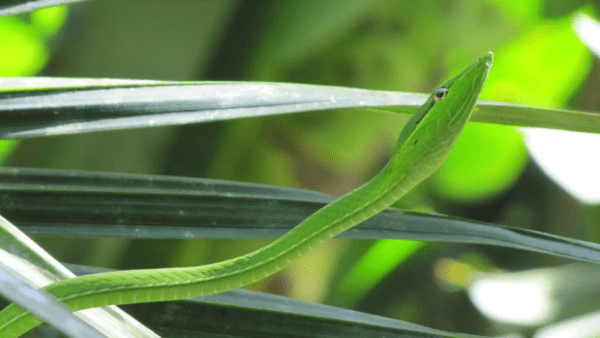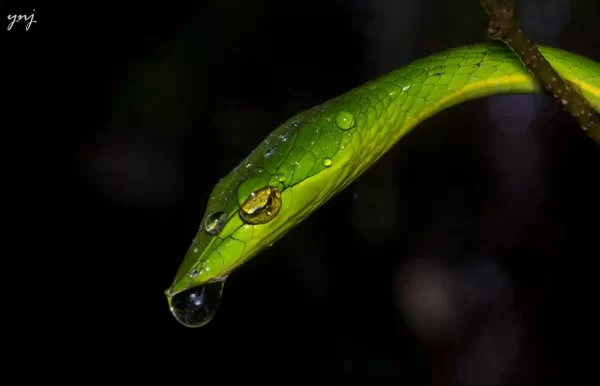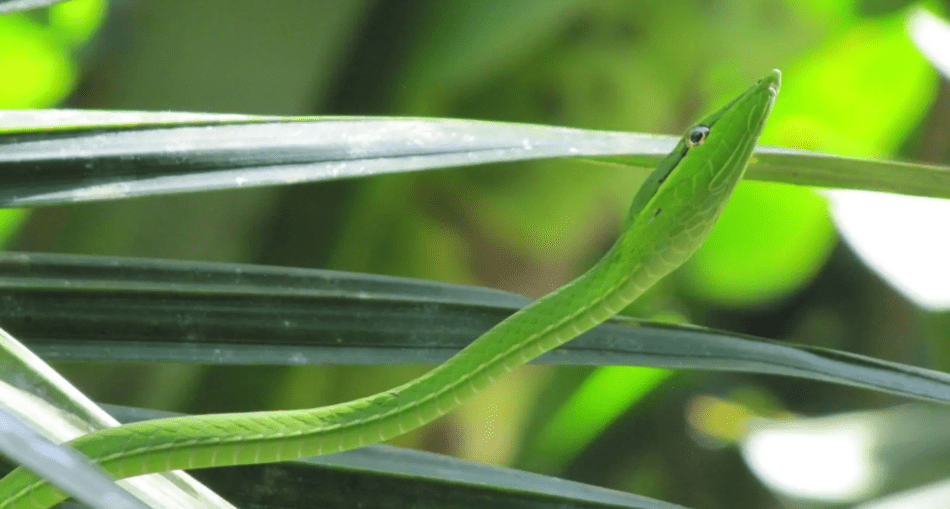The Green vine snake, or Oxybelis fulgidus, is a captivating yet mildly venomous snake found in the lush tropical forests of Guyana and beyond.

The Green vine snake [Photo: Leonor Enking]
APPEARANCE OF THE GREEN VINE SNAKE
The Green vine snake is unmistakable with its sleek, elongated body, reaching lengths between 1.5 and 2 metres.
The body is vividly green on the upper side and shifts to a yellowish-green underside, adorned with a delicate yellowish-white stripe along the belly and tail.
The snake’s head is distinctively aerodynamic and pointed, with a large mouth extending nearly the full length of the head—an adaptation well-suited for seizing prey.
Its thin tail is not only long but highly flexible, allowing it to anchor itself securely while reaching for prey among the branches.
Its remarkable green colouration not only offers camouflage but also highlights its sleek, nearly two cm thickness. This slim form allows the snake to blend seamlessly into foliage, giving it a stealthy advantage over unsuspecting prey.
FUN FACT: This snake’s body is incredibly slender, only about two cm thick, allowing it to move through foliage unnoticed.
GEOGRAPHIC DISTRIBUTION AND HABITAT
In Guyana, the green vine snake thrives in tropical, moist and dry forests, as well as in forested areas along sandy coastlines. It can spend most of its life in the trees, high above ground level.
This arboreal lifestyle provides both safety and an excellent vantage point for hunting.
BEHAVIOUR AND HUNTING TACTICS
The Green vine snake is primarily diurnal and spends most of its day hidden in tree branches. It patiently waits for prey as a solitary ambush predator, often blending into foliage until an opportunity arises.
When small animals such as lizards, frogs, or even birds come within range, the snake descends gracefully, using its elongated form to follow the prey for a short distance, often checking its scent with rapid tongue flicks.
A unique aspect of its predatory behaviour is the snake’s method of immobilising prey. The Green vine snake possesses two slightly larger rear teeth that, while blunt, allow the snake to inject its mildly toxic saliva.

Photo: Yogendra Joshi
This toxic saliva quickly paralyses small animals, allowing the snake to lift its catch off the ground, often 20-40 cm, before swallowing it whole. The process ensures the prey cannot retaliate, making it an efficient and controlled capture.
FUN FACT: Its eyes work in tandem, helping it zero in on prey with precision—a useful trait for an ambush predator.
DIETARY HABITS
As a carnivore, the Green vine snake eats a variety of small creatures, such as frogs, lizards, birds, and occasionally small mammals.
Its carnivorous diet and ability to adapt hunting techniques make it an essential part of Guyana’s ecosystem.
REPRODUCTION AND LIFECYCLE
The reproductive habits of the Green vine snake are as intriguing as its hunting strategies. A female typically lays between six and ten eggs, with an incubation period of around 100 days.
Hatchlings, or snakelets, are independent of birth and immediately begin their lives in the trees, relying on instinct to survive and hunt.
POPULATION STATUS AND CONSERVATION
The green vine snake is listed as the least concerned on the IUCN Red List. Its population numbers are stable across its range, and there are no significant threats to its existence at present.
However, like many species dependent on forested habitats, it could face challenges from deforestation and habitat loss in the future.
For now, though, the Green vine snake continues to thrive, playing a vital role in the forest ecosystems of Guyana and beyond.
REFERENCES
- https://en.wikipedia.org/wiki/Oxybelis_fulgidus
- https://animalia.bio/green-vine-snake?environment=110
- https://www.iucnredlist.org/species/198389/2523790







